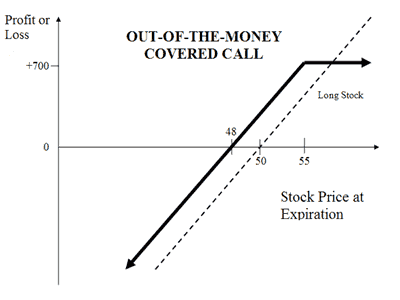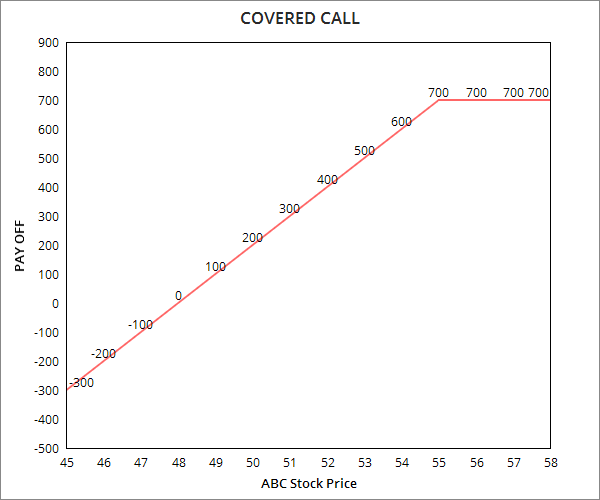 Zerodha (Trading & Demat Account)
Zerodha (Trading & Demat Account)
FREE Equity Delivery and MF
Flat ₹20/trade Intra-day/F&O
 Zerodha (Trading & Demat Account)
Zerodha (Trading & Demat Account)
FREE Equity Delivery and MF
Flat ₹20/trade Intra-day/F&O

|
|
Published on Wednesday, April 18, 2018 | Modified on Wednesday, June 5, 2019

| Strategy Level | Advance |
| Instruments Traded | Call + Underlying |
| Number of Positions | 2 |
| Market View | Bullish |
| Risk Profile | Unlimited |
| Reward Profile | Limited |
| Breakeven Point | Purchase Price of Underlying- Premium Recieved |
A Covered Call is a basic option trading strategy frequently used by traders to protect their huge share holdings. It is a strategy in which you own shares of a company and Sell OTM Call Option of the company in similar proportion. The Call Option would not get exercised unless the stock price increases. Till then you will earn the Premium. This a unlimited risk and limited reward strategy.
Let's assume you own TCS Shares and your view is that its price will rise in the near future. You will Sell OTM Call Option of TCS at a price, where you target to sell your shares. You will receive premium amount for selling the Call option and the premium is your income.
The covered call option strategy works well when you have a mildly Bullish market view and you expect the price of your holdings to moderately rise in future.
Suppose you are holding 100 shares of ABC company trading at Rs 50 in May. You are bullish on your holdings but are also worried about the downside i.e losses if there is fall in the price. In such a scenario, you can implement a Covered Call option strategy by selling a June 55 Call of Lot Size 100 at Over The Money (OTM) available at a premium of Rs 2. Since you are selling an option, you will receive Rs 2 X 100= Rs 200.
| ABC Stock Price | Rs 50 |
| Short Call Option Strike Price | Rs 55 |
| Option Lot Size | 100 |
| Premium Received | Rs 200 |
| Break Even Point (Purchase Price of Underlying - Premium Received) | Rs 48 |
Your total investments in the trade will be the cost of holding 100 shares minus the premium received i.e.
Cost of holdings (Rs 50 X 100= Rs 5000) - Premium Received (Rs 200)= Rs 4800
Now let's discuss about the possible scenarios:
Scenario 1: Stock price of ABC rises to Rs 57.
Here the strike price on expiry (Rs 57) is greater than the strike price of sold Call Option (Rs 55). The Call Option in such a case would be assigned and you will sell the holding shares and make a profit of (Rs 57- Rs 55) X 100= Rs 200. Your total profit, after adding Rs 200 from the premium received on selling the Call Option, would be Rs 400.
Scenario 2: Stock price of ABC falls to Rs 40
Your holding will lose (Rs 50-Rs 40= Rs 10) X 100= Rs 1000 in value. Since you would not be selling the shares, this loss would only be in the paper. Moreover, the loss will get reduced if you factor in Rs 200 premium received on selling the call option. So, the total loss on paper would be Rs 800.
| Stock Price on Expiry | Net Payoff(Rs ) [(Stock Price - BEP) x 100] BEP=48 MAX PROFIT= 700 |
| 45 | -300 |
| 46 | -200 |
| 47 | -100 |
| 48 | -0 |
| 49 | 100 |
| 50 | 200 |
| 51 | 300 |
| 52 | 400 |
| 53 | 500 |
| 54 | 600 |
| 55 | 700 |
| 56 | 700 |
| 57 | 700 |
| 58 | 700 |

When you are expecting a moderate rise in the price of the underlying or less volatility.
Let's assume you own TCS Shares and your view is that its price will rise in the near future. You will Sell OTM Call Option of TCS at a price, where you target to sell your shares. You will receive premium amount for selling the Call option and the premium is your income.
Purchase Price of Underlying- Premium Recieved
Maximum loss is unlimited and depends on by how much the price of the underlying falls. Loss happens when price of underlying goes below the purchase price of underlying.
Loss = (Purchase Price of Underlying - Price of Underlying) + Premium Received
You earn premium for selling a call. Maximum profit happens when purchase price of underlying moves above the strike price of Call Option.
Max Profit= [Call Strike Price - Stock Price Paid] + Premium Received
Underlying rises to the level of the higher strike or above.
Underlying below the premium received
It helps you generate income from your holdings. Also allows you to benefit from 3 movements of your stocks: rise, sidewise and marginal fall.
Unlimited risk for limited reward.


FREE Intraday Trading (Eq, F&O)
Flat ₹20 Per Trade in F&O
|
|